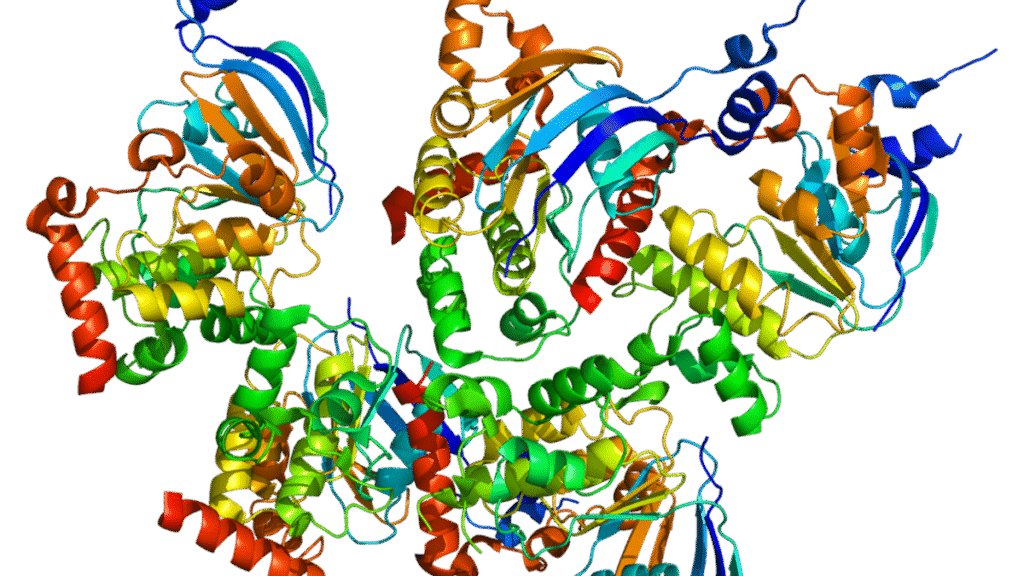
A rendering of the structure of the CFTR protein
| Photo Credit: Emw, CC BY-SA 3.0 <https://creativecommons.org/licenses/by-sa/3.0>, via Wikimedia Commons
Have you heard of Cystic fibrosis? If you haven’t this month, May, is Cystic Fibrosis Awareness Month, and makes for a good time to learn about the condition!
What is cystic fibrosis?
Cystic fibrosis or CF, is a genetic condition that causes the mucus in the body to become thick and sticky instead of being thin and slippery. When there is a build-up of thick mucus, it can cause clogs and blockages, damaging the lungs, pancreas and other organs in the body. It is a progressive condition and can get worse over time.
CF occurs, when there is a mutation or change to a gene known as the CFTR gene. The gene makes a protein that helps move chloride to the surface of cells. When chloride moves out of a cell, it takes water with it, thinning out the mucus. When the protein is not working correctly due to the gene mutation, this process is disrupted, leaving the mucus thick.

Whom does CF affect?
CF is a genetic condition. People who inherit two mutated CFTR genes, one each from their and mother and father, are born with this condition. There does not have to be family history of the condition for someone to be born with it. People who have only one copy of the defective gene are carriers.
While CF is more common in people of Caucasian descent, research in India has suggested that it is not as rare in the country as it was previously thought to be. In India, the first CF case was reported in 1968. A 2024 research paper, ‘Diagnosis and treatment of cystic fibrosis in India: What is at stake for developing countries?’ states that India is said to have the most number of undiagnosed CF patients in the world. The paper adds that although the exact prevalence of CF among Indians is unknown, it is estimated to be 1:43,321 to 1:100,323. Estimates vary however, and exact numbers for India are not known: another 2024 research paper, ‘Diagnosis of Cystic Fibrosis Beyond Childhood in India,’ states that while in India, the true incidence of CF is unknown, it is estimated to be 1:10,000–1:40,000 based on data from migrant Indian populations in the U.S. and U.K., respectively. With a population of [over] 1.3 billion, this could translate to high absolute numbers, it notes. The Cystic Fibrosis Trust of India, a non-profit working to further the cause of children with CF, estimates that there about 39,000 people living with CF in India.
What are the symptoms of CF?
CF symptoms depend on the organs that it affects and vary from person to person. CF mainly affects three systems: the respiratory system, the digestive system and the reproductive system.
Symptoms include: salty-tasting skin, a nagging cough, sometimes with phlegm, frequent lung infections such as pneumonia or bronchitis, wheezing, shortness of breath, repeated sinus infections, poor growth in spite of a good appetite, nasal polyps, clubbed fingertips or toes, oily or greasy stools, blocked intestines in babies, constipation, rectal prolapse and pancreatitis.
What are its complications?
Frequent respiratory infections are one common complication due to bacteria becoming trapped in the airways due to the thick mucus. Over time this can damage the lungs and lead to loss of lung function or to lung collapse. In the digestive system, the pancreas may be affected, causing a decrease in the enzymes that help digest food, causing trouble with the absorption of nutrients. This may put the person at risk of malnutrition and also at risk of other conditions such as lower bone density. Damage to the pancreas may also lead to glucose intolerance and CF-related diabetes. The liver may also get affected in some people with CF, causing liver disease.
CF can also affect fertility. Men with CF may have congenital bilateral absence of the vas deferens, a condition where the sperm-carrying tubes are not present. In women it may cause thicker cervical mucus or irregular ovulation.
How is CF treated?
There is no cure for CF, but treatment can help manage symptoms and lessen complications. Research is ongoing in gene therapy. At present treatment involves keeping airways clear and preventing infections and ensuring that the person gets adequate nutrition and preventing intestinal blockages.
Treatment can involve breathing techniques and airway clearance therapy, or the use of devices. Medications may include those to thin the mucus, medications called CFTR modulators to make the faulty protein work better, antibiotics to prevent or treat infections, pancreatic enzyme supplements to help take in nutrients and stool softeners. People with an advanced form of the condition may need a lung or liver transplant. A special diet plan may also be recommended.
Newer therapies have now increased the lifespan of those with CF. Careful management can help improve quality of life. Regular check-ups are important, as is finding support for mental health care if needed. Always consult a doctor if you believe you or a family member have symptoms.
Published – May 07, 2025 06:19 pm IST

